|
Heavy Hitters
Builder Online - May 1997
 Framers
are bred for speed -- but nobody sets the pace like production framers.
What makes them so fast and efficient? Here's the second in BUILDER's
two-part series on high-volume framers and how they cut cycle time,
improve design, and save money for their builders. Framers
are bred for speed -- but nobody sets the pace like production framers.
What makes them so fast and efficient? Here's the second in BUILDER's
two-part series on high-volume framers and how they cut cycle time,
improve design, and save money for their builders.
[CAPTION:
Prebuilding and lifting components (right)
as a unit make custom features fit into production
framing. Here the conical roof is on its way to the tower.]
California framer Scott Shaddix suddenly looked up at Hank Mailand of
Taylor Woodrow Homes. They'd both just heard a great idea.
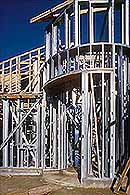 [CAPTION:
This year, approximately one-half of Nicholas Lane's
800 units will be steel-framed (left),
many with custom features.] [CAPTION:
This year, approximately one-half of Nicholas Lane's
800 units will be steel-framed (left),
many with custom features.]
"Most people don't include rim-joists in their structural
calculations," engineer George Richards of Borm Associates was
saying. "But if we change some of your rim-joists from 114"
Timberstrand to 134" microlams, I think you could eliminate a number
of headers."
Shaddix and Mailand were going stick by stick through a new Taylor
Woodrow design with Richards and Mark Davis of Trus Joist MacMillan,
exploring Shaddix's idea to frame the exterior walls with engineered
lumber and the interior with light-gauge steel.
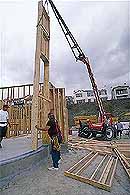 As
Richards and Davis calculated the strength and cost of Trus Joist's
engineered rim-joist, Shaddix and Mailand counted headers. As
Richards and Davis calculated the strength and cost of Trus Joist's
engineered rim-joist, Shaddix and Mailand counted headers.
[CAPTION:
Custom features can
be built competitively. Nicholas Lane's carpenters build curved wall
sections on the ground and lift them into place (right).]
"That meeting was definitely unusual," says Trus Joist's
Davis. "Scott came up with this framing system and got us together to
check it out. Getting engineers to consider radical changes is a huge
step."
That's one reason Taylor Woodrow works with Shaddix's company, Nicholas
Lane Contractors of Buena Park, Calif.
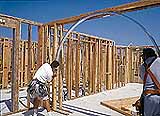 [CAPTION:
Shaddix uses new technology, like curved steel
arches and bent steel plates
(left) for
curved walls. Some innovative products come from RV manufacturing.] [CAPTION:
Shaddix uses new technology, like curved steel
arches and bent steel plates
(left) for
curved walls. Some innovative products come from RV manufacturing.]
"Scott is unique," says Mailand, Taylor Woodrow's research
and product development director. "This was a totally new concept
that he brought to us. Our other framers don't do that."
New-Age Framers
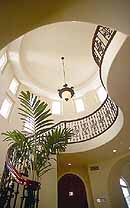 Shaddix
is part of a new generation of innovative production framers offering new
services to big builders in hot markets. His company will frame more than
800 homes this year from Los Angeles to San Diego. Shaddix
is part of a new generation of innovative production framers offering new
services to big builders in hot markets. His company will frame more than
800 homes this year from Los Angeles to San Diego.
[CAPTION:
Custom features
like the round stairwell shown here (left),
as well as towers and curved walls, are common in California production
homes, and framers are challenged to build them efficiently and at
production prices. ]
Not all of these framing companies try to bring new products to their
builders, however. Most make some of their most meaningful innovations
just helping builders improve existing framing systems.
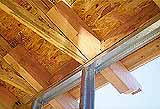 [CAPTION:
Wood roof
trusses (right)
with decorative tails added on cap off a
steel-framed wall. ] [CAPTION:
Wood roof
trusses (right)
with decorative tails added on cap off a
steel-framed wall. ]
The best framers help their builders in a variety of ways. They help
simplify plans, take over the purchase of materials, improve on-site
efficiencies and production, and create new approaches to customer
service.
Ace Carpentry of Manassas, Va., is a perfect example. The company
employs 175 carpenters and will frame about 800 homes this year -- 250
alone for Pulte's Virginia division.
As part of Pulte's Subcontractor and Supplier Qualified Leadership
group, Ace reviews plans and meets with other trades to work out
construction details.
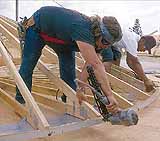 [CAPTION:
Even the conical roofs for round towers are framed
on the ground (left).] [CAPTION:
Even the conical roofs for round towers are framed
on the ground (left).]
"We've been helping Pulte clean up their blueprints so the specs
and plans are clearer," says Ace's Ken Shifflett. "We call it
the Red Line process."
Shifflett used to get conflicting information on plans that would take
hours to sort out -- hours taken away from production.
"The architects would draw roof and floor systems on the plans,
then send them out to component manufacturers for engineering," says
Shifflett. "We'd actually end up with two sets of plans on site; one
with the architect's specs, and the other with the engineer's."
After going through this system with Pulte, everyone agreed that the
structural engineer would have the last say.
Using the same process, Ace helped Pulte update its plans so subs were
bidding on the most current version.
"As a design evolved, they'd keep adding to the plans, so the
house changed even though the model name didn't," Shifflett says.
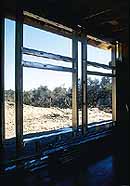 [CAPTION:
By installing
structural headers tight to the top plates (right),
Shaddix avoids putting cripples on layout and can downsize the other
headers.] [CAPTION:
By installing
structural headers tight to the top plates (right),
Shaddix avoids putting cripples on layout and can downsize the other
headers.]
The biggest innovation Ace brought to Pulte affected the company's
purchasing policy. Ace convinced Pulte to let Ace supply its own framing
materials. While this is common in other markets, it's new to many large
Virginia builders.
"This was their idea," says Pulte's construction VP Allegro
Parker. "I like the way it's working. Best of all, once Ace began
supplying its own materials, all the extras went away, site clean-up went
away, and dumpster pulls disappeared. We're better able to project house
costs because of it."
STATS
NICHOLAS LANE
CONTRACTORS,
Buena Park, Calif.

- Founded, 1987
- Annual production: 800 units
- Number of employees: 300
- Gross revenue, 1997: $12 million (projected)
Builder-clients include Brookfield Homes, Home
Devco, Polygon Communities, Shea Homes, Taylor Woodrow Homes.
Innovative company specializing in production
framing using wood, engineered lumber, and steel framing. Up to one-half
of annual production are steel framed homes.
[CAPTION:
Scott Shaddix
(above),
president of Nicholas Lane Contractors, is developing a framing system
that uses engineered lumber for exterior studs and light-gauge steel for
interior partitions.]
Fast & Faster
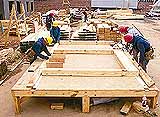 Besides
introducing big ideas and new concepts, both Shaddix and Ace Carpentry
president Anthony Clatterbuck constantly hone the basic moves that make
their companies stand out. Besides
introducing big ideas and new concepts, both Shaddix and Ace Carpentry
president Anthony Clatterbuck constantly hone the basic moves that make
their companies stand out.
[CAPTION:
On big projects (right),
Ace sets up its production line to build wall panels. The cutting station (rear)
feeds the nailing station (middle)
where headers and jacks are fastened, and it all ends up on the panel
table (foreground).]
While they both manage multimillion-dollar operations and juggle
sophisticated schedules, they still approach new projects with a framer's
mentality: plan it out, set it up, work hard, go fast, and move on.
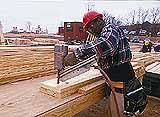 [CAPTION:
William Lindsay
(left) is
one of Ace's Industry Education Alliance trainees who the company hired at
the end of his apprenticeship. Lindsay assembles precut headers and jacks
for the wall panel crew.] [CAPTION:
William Lindsay
(left) is
one of Ace's Industry Education Alliance trainees who the company hired at
the end of his apprenticeship. Lindsay assembles precut headers and jacks
for the wall panel crew.]
"All this planning we do with builders translates directly into
savings and efficiencies on site," says Shaddix. "We want to
reduce the number of moves we have to make. And the less we have to think
on the slab, the faster we can go."
Shaddix accomplishes this first on paper, then on site.
On paper, he marks up and color codes the plans. He marks the locations
of shear walls on the plans so framers won't place bracing until after
they have installed the shear materials. He makes separate sheets to show
layout and dimensions of ceiling drops for HVAC, structural hardware and
installation sequence, floor framing, door and window opening call-outs,
truss hardware, and truss layout. The sheets show where to start layout
and the order of assembly.
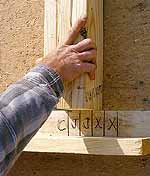 [CAPTION:
The wall crew merely has to place materials onto the
table and locate them according to the layout plates. Nobody needs a tape
measure. Here (right),
two jacks and a stud -- already nailed together -- slide into place.] [CAPTION:
The wall crew merely has to place materials onto the
table and locate them according to the layout plates. Nobody needs a tape
measure. Here (right),
two jacks and a stud -- already nailed together -- slide into place.]
Shaddix also prints layout cards for each window and door opening that
list the location, rough opening dimensions, and parts list -- all taken
straight from his computerized specs for each house.
These cards are stapled to the wall plates during layout and stay up
through construction to reduce any confusion about the window or door for
that spot.
 [CAPTION:
One of Ace's best innovations is its on-site wall
panel table (left),
which it uses on large projects with repetitive wall layout. Framers
insert layout plates for different walls into the slots in the plywood.
The layout plates have stud, window, and door locations already laid out.] [CAPTION:
One of Ace's best innovations is its on-site wall
panel table (left),
which it uses on large projects with repetitive wall layout. Framers
insert layout plates for different walls into the slots in the plywood.
The layout plates have stud, window, and door locations already laid out.]
On site, Shaddix sets up what he calls "the moving assembly
line." A foreman checks grades at all corners and bearing walls on
all waiting slabs, marking them onto blank floor plans. The concrete
contractor then makes necessary corrections to bring the slabs into
tolerance.
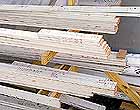 [CAPTION:
One person does all the wall layout for this project
on these layout plates (right).
The plates are then used on the wall panel table (see
photo above left).] [CAPTION:
One person does all the wall layout for this project
on these layout plates (right).
The plates are then used on the wall panel table (see
photo above left).]
Once a slab is ready to go, another worker pulls layout and snaps
chalk-lines. He's followed by a plate man who cuts and places wall plates
and another layout man who marks framing layout onto the plates and
installs the window/door layout cards.
These specialists are followed by crews for walls, floors, and trusses.
Each crew has workers whose sole function is to spread lumber packages and
feed materials to framers.
In contrast, Ace Carpentry's crews stay on each house through all
framing stages.
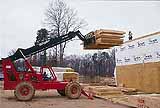 [CAPTION:
Ace owns nine forklifts and a crane. Wall panels are
an easy lift for this extending forklift (left).
The lead man guides the operator with a handheld radio.] [CAPTION:
Ace owns nine forklifts and a crane. Wall panels are
an easy lift for this extending forklift (left).
The lead man guides the operator with a handheld radio.]
"Our crews go from bottom plates to roof," says Clatterbuck.
"They build exterior cornices, install windows and doors, and punch
out each house."
Clatterbuck says this approach separates his company from its
competition. "We believe in the complete product," he says.
"When we put the last piece of plywood in place, we're done; we don't
have to go back and nail or adjust anything."
On large projects, Ace sets up what looks like a factory production
line. A radial arm saw cutting station feeds precut pieces to a nailing
station, which feeds components to a wall crew working on a wall panel
table. Forklifts feed wall panels to framers on the decks.
"Nobody gets off the deck for materials," says Shifflett.
"The rule for our carpenters is: 'Keep your heads down and nail.
Stockers will feed you materials.'"
STATS
ACE CARPENTRY,
Manassas, Va.
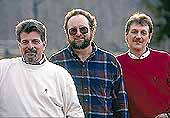
- Founded,1983
- Annual production: 800 units
- Number of employees: 200
- Gross revenue 1997: $11 million (projected)
Builder-clients include Pulte Homes, Foster
Communities, W. M. Foley Construction, Equity Homes, Craftmark Homes,
Rhinehart Homes.
Company focuses on speed, efficiency, cost
savings, and safety. Very active with Industry Education Alliance to help
train carpentry labor force. Production framing techniques applied to
custom framing as well.
[CAPTION:
(above) Ace
Carpentry's president Anthony Clatterbuck (center),
and vice presidents Ken Shifflett (right),
and Gary Long (left) say the
key to their success is finding and keeping great employees. They've
started building affordable homes for their employees close to work.]
 These
heavy hitters are always looking for ways to improve. They ask their
builders for more complete framing plans. They want more information on
floor and roof systems, bearing points, wall-to-wall dimensions,
center-line dimensions for openings, cabinet layout, tub enclosures, and
HVAC duct chases. These
heavy hitters are always looking for ways to improve. They ask their
builders for more complete framing plans. They want more information on
floor and roof systems, bearing points, wall-to-wall dimensions,
center-line dimensions for openings, cabinet layout, tub enclosures, and
HVAC duct chases.
[CAPTION:
"The next piece is always waiting -- that's the
trick," says Ken Shifflett. Production framing relies on tight
teamwork like this (right).]
What really gets them excited are the innovations they make in the
field.
Both companies are prebuilding more components, like window and door
openings, arches, bump-outs, and fireplace enclosures. They're searching
for state-of-the-art tools and fasteners that can make working with some
of the new materials -- like engineered lumber and light-gauge steel -- go
faster and more easily.
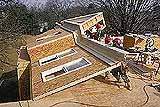 [CAPTION:
Even their custom homes get production treatment.
Ace carpenters frame exterior walls and bump-outs, install the windows,
and add the cornice and trim to the walls before tilting them up
(left). It's
not only faster, but safer, too. "We were in business for five years
before we owned a ladder," says Shifflett.] [CAPTION:
Even their custom homes get production treatment.
Ace carpenters frame exterior walls and bump-outs, install the windows,
and add the cornice and trim to the walls before tilting them up
(left). It's
not only faster, but safer, too. "We were in business for five years
before we owned a ladder," says Shifflett.]
The next big challenge for production framers like Nicholas Lane and
Ace Carpentry will be figuring out how to build custom features -- like
towers and curved walls -- for production prices. It'll be another way to
stay ahead of the competition. Shaddix is already doing this.
"A lot of framers look at round towers [in California] and say,
'No way,'" he says. "But you can't say that. You've got to say,
'No problem -- and no extra cost.' "
|

